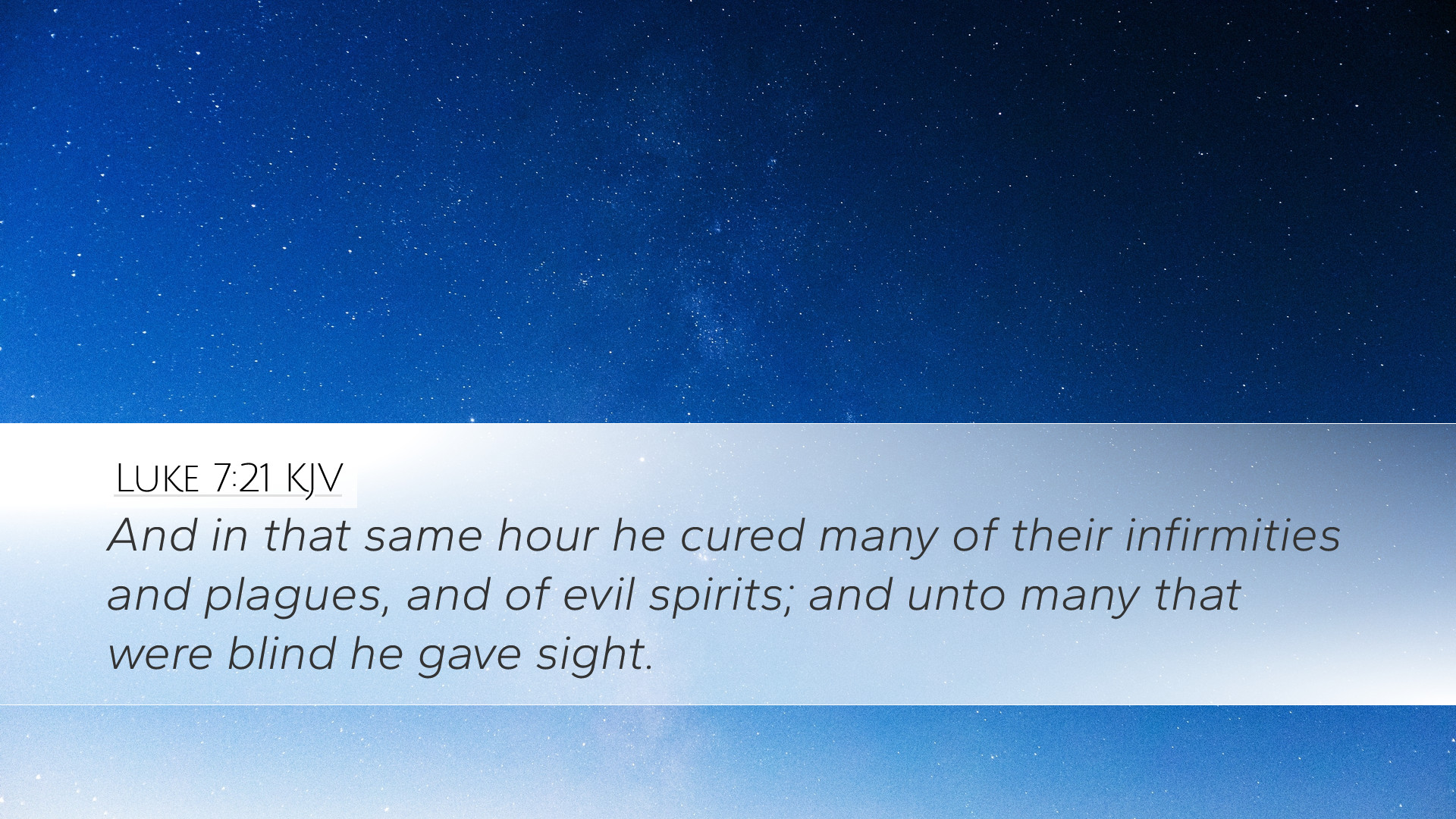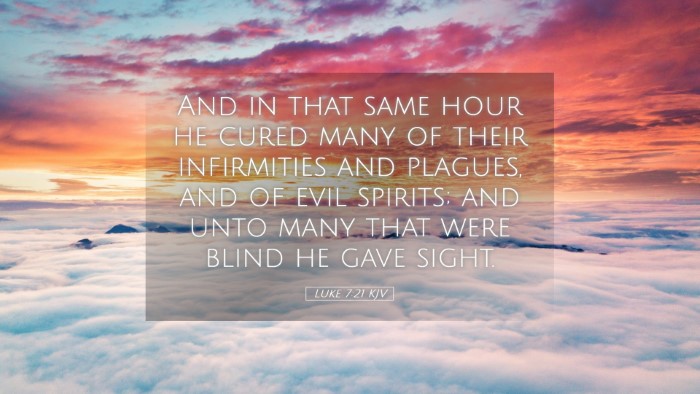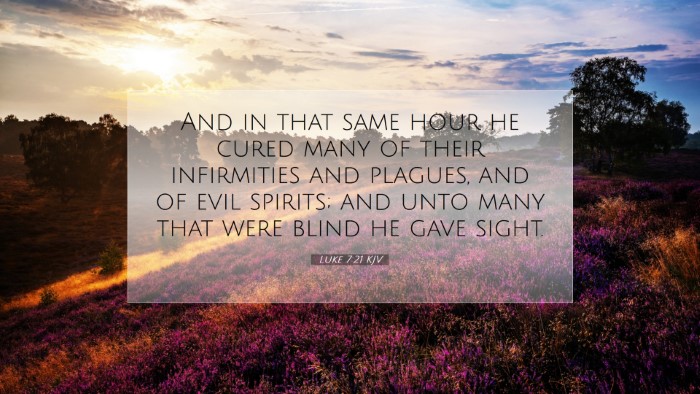Commentary on Luke 7:21
Luke 7:21 states, "In that hour he cured many of their infirmities and plagues, and of evil spirits; and unto many that were blind he gave sight." This verse marks a vital moment in the ministry of Jesus, reflecting His compassion and divine authority. The verse is pivotal to understanding both the character of Jesus and the nature of His mission.
Contextual Analysis
To fully comprehend the significance of this passage, it is essential to consider the surrounding verses. In Chapter 7, John the Baptist sends messengers to inquire if Jesus is the expected Messiah (Luke 7:19). In response, Jesus performs miraculous works. The timing of this inquiry is significant, as it illustrates John's doubt and the growing awareness of Jesus' ministry among the people.
Historical Setting
During this era, healing was associated not just with physical ailments but also with spiritual wellness. Jesus’ actions serve to reaffirm His identity and mission, validating the faith of the people while addressing John's doubts. The signs and wonders performed by Jesus were proclamations of the Kingdom of God and represented the fulfillment of Old Testament prophecies.
Theological Implications
The verse encapsulates key theological themes relevant to pastors, theologians, and students of the Word:
- Jesus' Authority: The miracles performed reinforce Jesus' divine authority and His role as the Messiah. Matthew Henry notes that these acts were not performed for the sake of entertainment but to draw attention to His divinity.
- Compassion for Humanity: Jesus responds to the needs of the afflicted, showcasing His deep compassion and care for both physical and spiritual suffering. Adam Clarke emphasizes this point, highlighting that Jesus attended to the "infirmities" of the people, showing that the ministry of healing was central to His purpose.
- Fulfillment of Prophecy: The miracles serve as proof of Jesus fulfilling the expectations of the Messiah as laid out in Isaiah 61:1-2. Albert Barnes stresses that Jesus' actions reinforced the prophetic assurances of God’s intervention in human suffering.
Insights from Public Domain Commentaries
Matthew Henry’s Commentary
Matthew Henry emphasizes the proactive nature of Jesus' healing ministry, noting that He did not wait for the afflicted to come to Him but sought them out. His approach illustrates the active love of God seeking to restore the lost and broken. Henry points out that the phrase "In that hour" indicates a moment of divine intervention, where Jesus reflects the epitome of God’s grace and power in addressing human frailty.
Albert Barnes’ Insights
Barnes provides a thorough exploration of the nature of physical and spiritual healing. He remarks on the importance of recognizing the holistic aspect of health that Jesus offers. Evil spirits, plagues, and blindness are not merely physical ailments; they represent the broader condition of fallen humanity. Barnes explains that every miracle performed by Jesus not only serves a physical need but also points to the ultimate spiritual healing and restoration found in Him.
Adam Clarke’s Perspective
Clarke, known for his detailed annotations, views this moment as critical in demonstrating the Kingdom of God’s presence through tangible acts of healing. He reflects on the reality of human suffering and the transformative power of Christ's interventions. Clarke emphasizes that receiving sight for the blind is symbolic of spiritual enlightenment, aligning with the broader themes of revelation and understanding within the Gospel narrative.
Application for Today’s Church
This verse challenges modern pastors and scholars alike to reflect on how the ministry of healing continues in the church today. The compassionate acts of Jesus set a precedent for how Christians should respond to the needs of those suffering around them. The call to be vessels of healing, both physically and spiritually, resonates deeply.
- Embrace Compassion: Like Jesus, the church is called to a ministry of compassion, seeking to address both physical and spiritual needs in communities.
- Holistic Healing: Understanding that healing encompasses body, mind, and spirit encourages a Christ-centered approach to pastoral care and counseling.
- Faith and Doubt: Just as John the Baptist had moments of doubt, modern believers may struggle with their faith. This verse assures them of Jesus’ ongoing work and presence even in times of uncertainty.
Conclusion
Luke 7:21 serves as a profound reminder of Jesus’ mission and His response to human suffering. The insights garnered from public domain commentaries emphasize that healing goes beyond mere physical restoration; it points to a deeper, more holistic salvation that Jesus offers. As the church continues to engage in this mission, it must embody the compassion of Christ, bringing both physical relief and spiritual awakening to a world in need.


